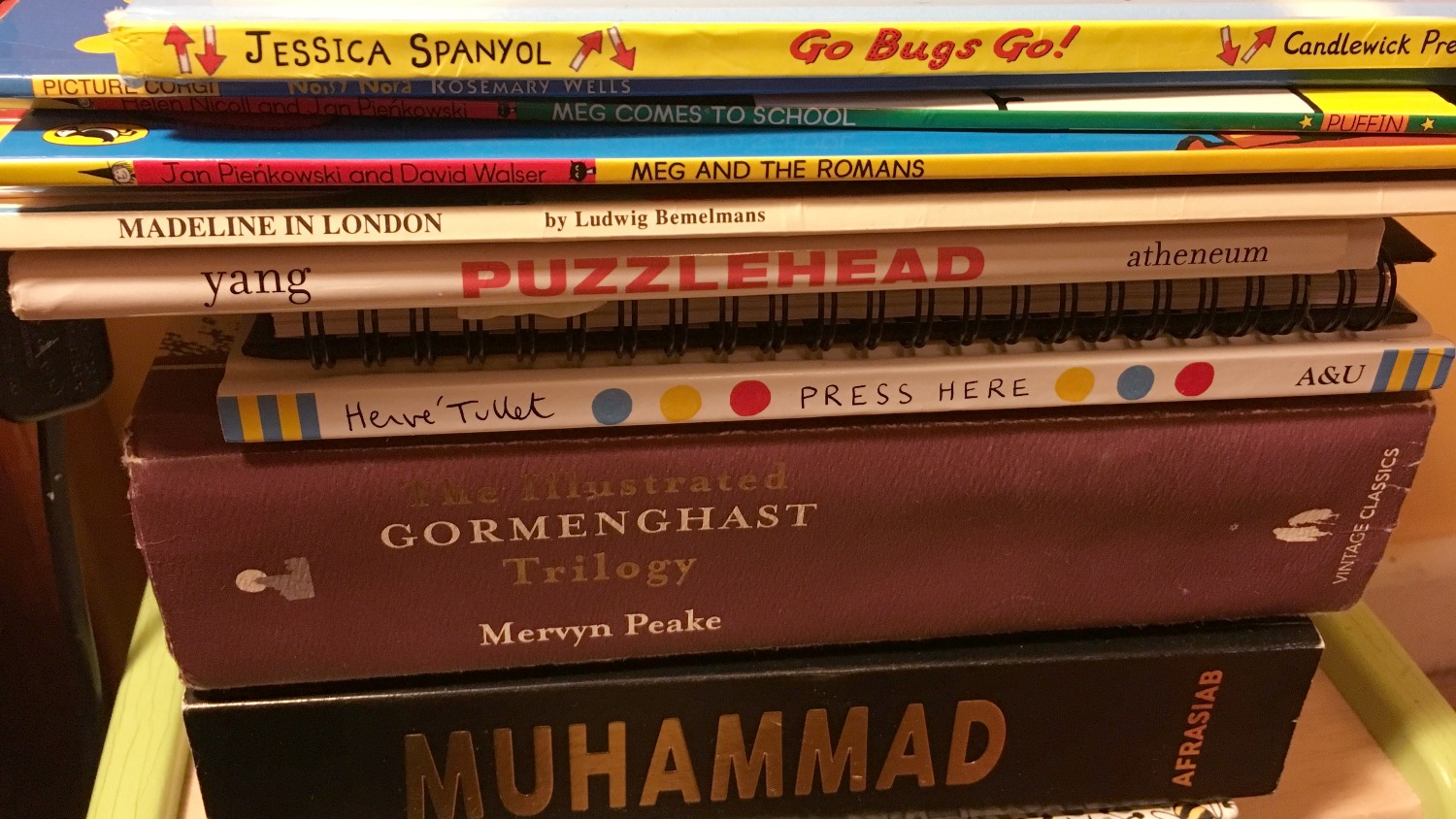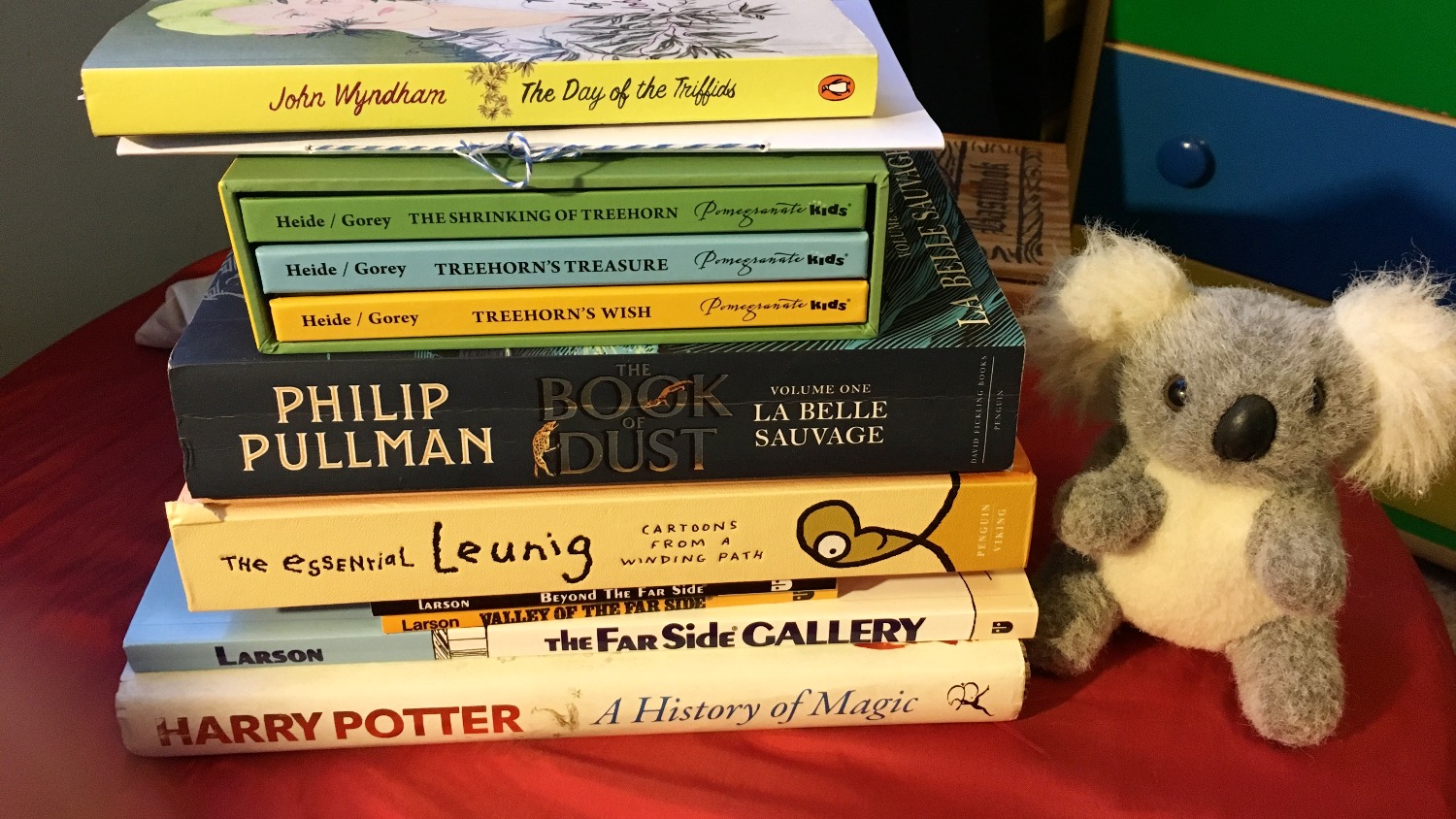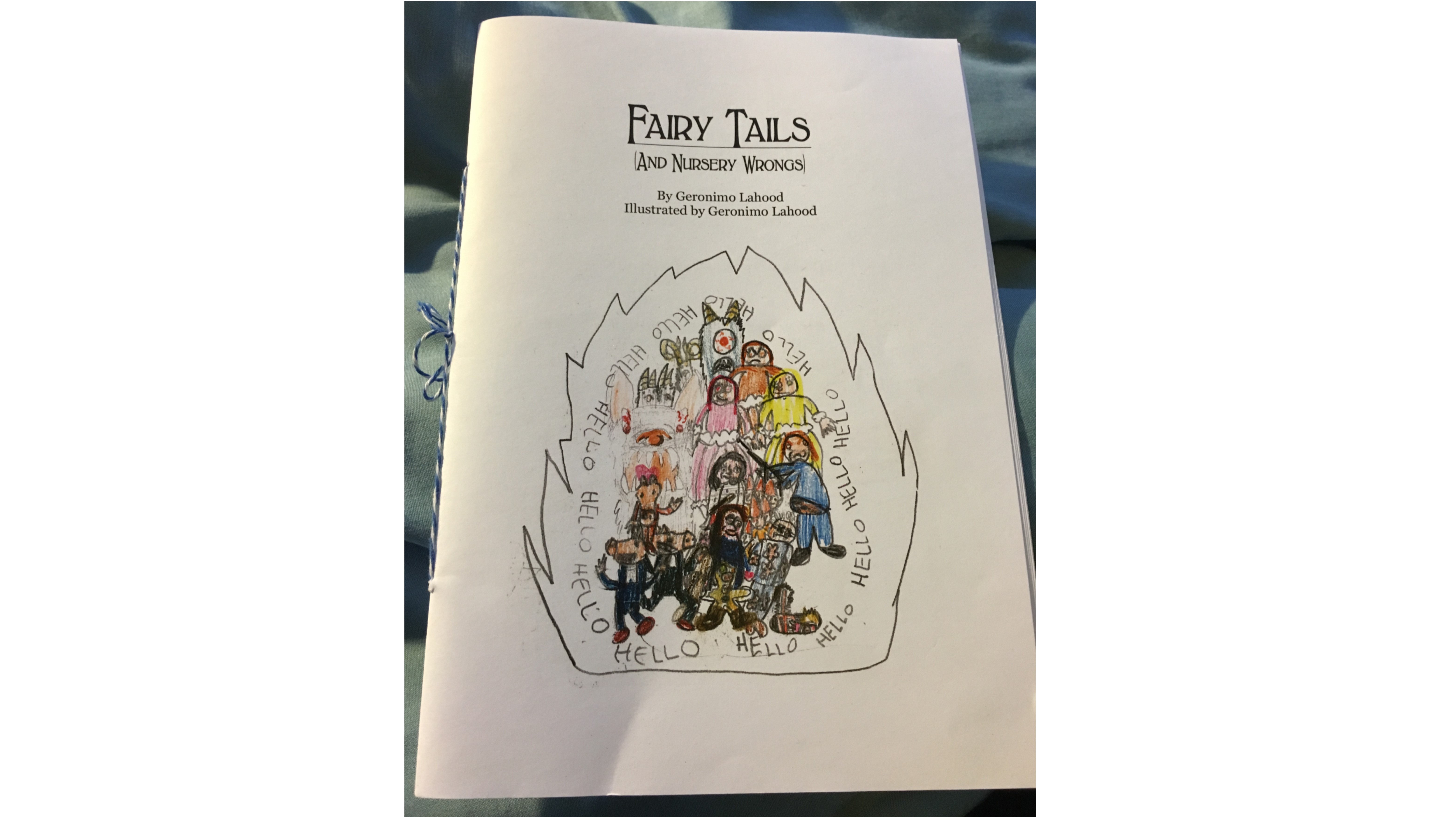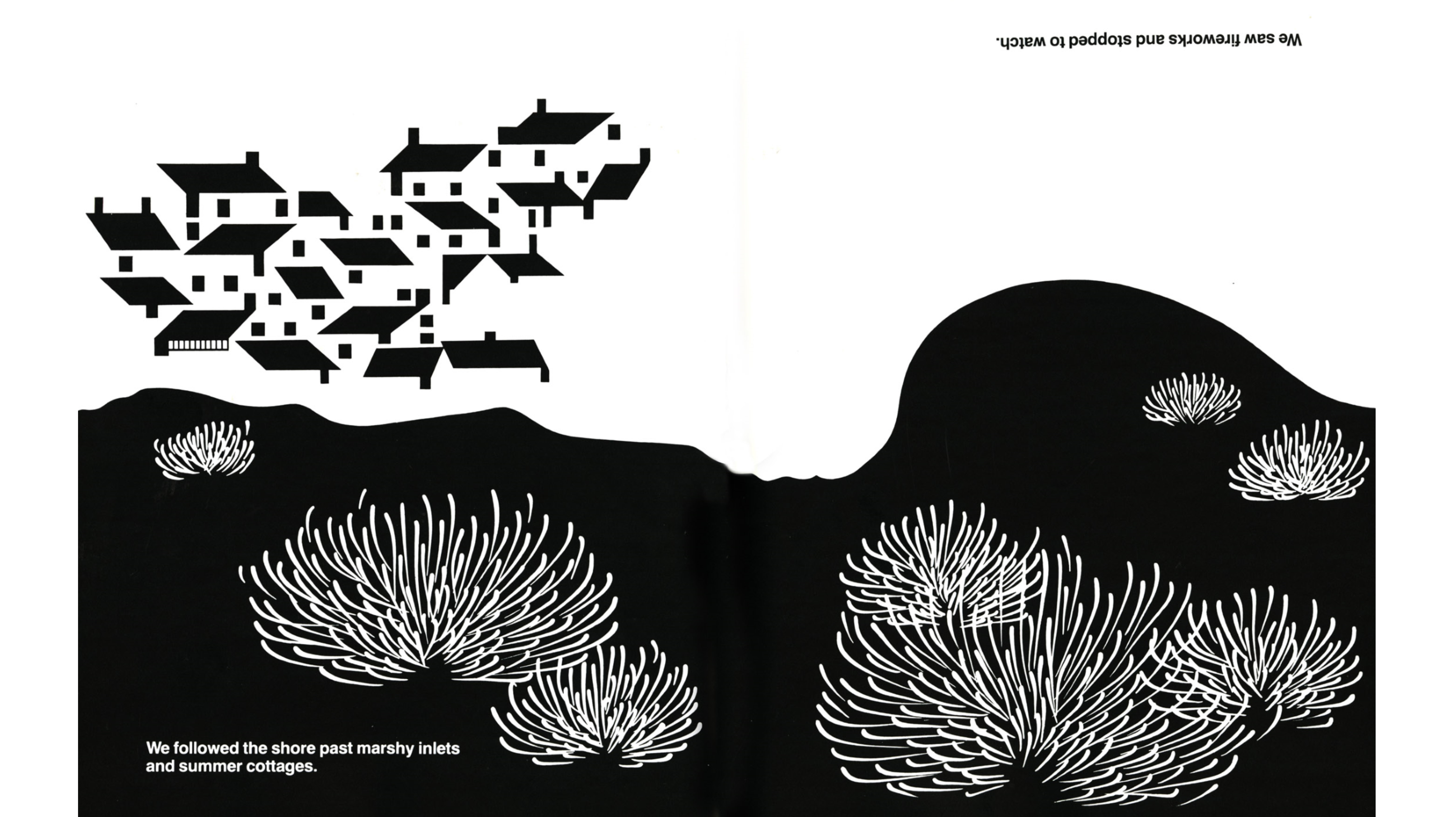Wellington-based writer and theatre-maker Jo Randerson is appearing in four events at the Wellington Writers & Readers Festival this month, including being a guest narrator in Peter and the Wolf. Here, she writes about the books her two children enjoy and reminisces about her own childhood reading.

Often people visit our house and are struck by the size of our bookshelves. I am equally struck by houses without books. These paper treasures are a major building block of family life here in Mornington, Wellington. We each have piles of unfinished books by our beds, and we frequently visit our local public library to embellish our brimming collection. We always get far too many books out – the bags break on the way home. We are greedy for words and pictures!
My son Caspar (6) often interacts with books as objects; for example, two of his favourite books in our house are the hefty tomes Muhammad and The Gormenghast Trilogy. Gormenghast used to sit high on the top shelf (I confess, I haven’t read it yet), but before Caspar could talk he would point insistently at it, until we got it down. I would not say we read these books in the traditional sense – but we enjoy them, their colour, shape, smell and their weight. When Caspar and I read together it is not so much about the story but the words, the feel of each individual page, and the repetition of patterns. The Meg and Mog series is a current favourite (although my favourite Jan Pienkowski book is Faces).
My son Caspar (6) often interacts with books as objects … I would not say we read these books in the traditional sense – but we enjoy them, their colour, shape, smell and their weight.
The first time Caspar and I read a book sets the precedent for every subsequent reading – whatever happens that first time must be replicated, including exact voices, the reading out of the title and copyright pages, dedications, hand-written inscriptions and a thorough examination of the ‘also written by’ list. Story time can be an exercise in patience for me, which is a great daily meditation. Caspar and I like interactive books, such as Press Here, Give & Take and Hello Red Fox. We read every night.

Geronimo (10) prefers graphic novels and cartoons. An early favourite was New York Snippets by friend Peter Salmon. Currently we are all enjoying a re-discovery of The Far Side, and Michael Leunig has been an ongoing favourite. Geronimo also writes his own books and has created his own logo for his publishing house. A former obsession was the Treehouse collection, and he is the very proud owner of an autograph by Andy Griffiths. He has also been reading The Day Of The Triffids – and this helps us learn at least one new word per page. This is another challenging parental moment: trying to concisely define a word for a ten-year old whose listening window is about six seconds. It’s an exercise in simplicity and accuracy under time pressure.

The I Spy series (Jean Marzollo and Walter Wick) swept through our house when we uncovered Aunty Zoe’s collection from the ‘90s. These are a terrific series of artfully staged, detailed images in which the viewer has to find certain items which are described written in rhyming couplets. Each scene has its own style, genre and setting, and the viewer can also create their own ways of interacting with the book, e.g. create your own lists for others to find. I always enjoyed these books which had a challenge in them, such as Anno’s Animals, especially when the challenge was open-ended and not exact – if that cloud looks like a rabbit to you, then it’s a rabbit!
I kept as many of my child-hood books as I could. The experience of re-reading them offers a mix of nostalgia as well as the occasional cringe.
I kept as many of my child-hood books as I could. The experience of re-reading them offers a mix of nostalgia as well as the occasional cringe. (Did I really like that sexist book? That book which encourages people to choose security in life above all else?) Then there is the added joy of sharing it with my children. Sometimes they love it, sometimes not. Sometimes my children experience some totally different joy in a book than what I experienced as a young person. That’s wonderful to me. Sometimes they point out the narrative flaws, or an action that seems cruel to them (e.g. The Elephant and the Bad Baby – the Elephant entrapped the baby into criminal activity. The Baby was just supporting the Elephant’s lead).
I remember the day Aranea by Jenny Wagner (1975) was first read to us at school. The black and white illustrations, the sheer energy of the storm, the vulnerability of the spider and her amazing tenacity in simply re-doing, with patience, what had been undone – this deeply affected me. I was also surprised by the non-traditional narrative structure, and how fulfilling the ending is despite not following an expected emotional arc. It’s a book that embedded itself into my consciousness. I gave my childhood copy away to a friend who had become a mother and then regretted passing it on. This has happened many times to me – as an adult I suddenly vividly remember a childhood book and become obsessed with finding it again, so I am frequenter of second hand bookstores. My memories of childhood books are very strong and I get quite obsessed with memories of particular editions. It’s sometimes a smell that I’m searching for.
My memories of childhood books are very strong and I get quite obsessed with memories of particular editions. It’s sometimes a smell that I’m searching for.
The discovery of form-breaking books had a huge effect on me as a child, for example Round Trip by Ann Jonas (1983). I remember thinking: What? Once you finish reading, you turn the book upside down and read again backwards through the book? The black and white images, now reversed, offer a different perspective. This was genuinely mind-blowing as a child. It’s innovative moments like these in books, brave stylistic and authorial choices, which make an impact on me. Like the genius of Sendak in Where the Wild Things Are, to enter fully into the illustrative world for the central emotional storm of the book, and leave all text behind for several double page spreads.

When we find a book that breaks traditional form, it’s a huge delight for all of us in our family. We often go to the Wellington Children’s Bookshop, to see what new offerings have blown in. Wellington’s also the home of Gecko Press, one of our favourite children’s publishers. When the Lucky Book Club forms come out we tell our kids they can instead buy one book from The Children’s Bookshop. Books are our rewards system and we know we can all walk out from a bookshop deeply happy.
Sometimes it’s easy to see why certain kids’ books were my favourites – the subversive, radical stance of the narrator, a female hero, a deeply pacifist theme.
Sometimes it’s easy to see why certain kids’ books were my favourites – the subversive, radical stance of the narrator, a female hero, a deeply pacifist theme. Other times colour, graphic or other aesthetic innovations drew me in, such as an exquisite end paper or a woven-in bookmark. And still other books, despite their narrative inadequacy, were read to me by a loved one, and that is why I hold on to old editions, because of the precious memory of that shared time together.
Jo Anderson
Writer and theatre-maker Jo Randerson is recognised as one of New Zealand’s most original voices. Jo’s published works include short-story collections The Spit Childrenand Tales from The Netherworld, and have won her the Robert Burns Fellowship, an Arts Foundation New Generation Award and the Bruce Mason Award for playwrighting. Her play The Spit Childrenpremiered at Antwerp’s largest youth theatre HETPALEIS in 2014. She is the founder and artistic director of Barbarian Productions theatre company whose new work Soft N Hardis touring New Zealand, and they are hard at work on a new children's theatre show Odd One Outwith Capital E National Theatre for Children for touring in 2018. Jo’s writing has recently appeared in the Journal of Urgent Writing, Pantograph Punchand Future Conditional: Notes for Tomorrow.



